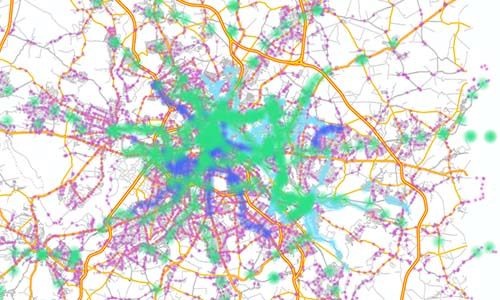Our mobility ecosystem is on the change. After decades of car-centric street design, cities more and more shift towards a more citizen-centered focus to create livable urban environments. Challenges like climate change and the growing urbanization urgently require a transition towards a more sustainable and efficient mobility system. New technologies and services play a decisive role here.
We talked with Christian U. Haas, the CEO of PTV Group, about mobility trends 2023.
Christian, let’s look back first. What developments in mobility stood out to you in 2022?

Christian U. Haas: In Germany, definitely the 9-€-ticket. 52 million people bought the subsidized public transport ticket this summer. Its introduction brought into focus the debate about affordable and, above all, attractive public transport as a pillar of sustainable mobility. And now Germany’s federal government and 16 states have formally agreed on a new national wide €49 monthly travel pass.
For us at PTV Group, the launch of PTV Model2Go stood out in 2022. Model2Go is a new technology to automize the building of standardized transport models. Basic transportation models can be set up for any city or region worldwide within days – a process that manually takes several months.
So far, model-based analyses often didn’t come into use because the model building process was expensive and time-consuming. Thus, Model2Go is a real game-changer in urban and transportation planning. It drastically reduces the time, effort, and cost of model-building. So making model-based decisions is viable – even for small projects. Users such as cities, consulting companies or research institutions receive a ready-made foundation on which they can directly implement simple and complex use cases.
What do you think will be the mobility trends of 2023?
Christian U. Haas: The EV uptake will have the greatest impact in the short term. Experts in the U.S. and in Europe are expecting EV sales to keep rising, but the charging infrastructure is still far away from being sufficient. In the U.S., the goal is to install 500,000 public chargers nationwide by 2030. A McKinsey study from 2022 estimates that this is not even enough, and that the U.S. would need 1.2 million public EV chargers and 28 million private EV chargers by that year. So, 2023 will be very much about how to rapidly expand the charging network. A systematic, demand-driven approach is urgently needed.
I also consider that the smart use of big data in mobility and logistics will become increasingly important. Today’s availability of big data is so far largely untapped, so there is massive potential. Not only in terms of machine learning and AI, but also in data analytics and visualization.
At PTV Group, we are working on a series of new dashboards to be released soon, that will deliver easily accessible mobility insights to cities. Last December, we released the first dashboard, PTV Access, to visualize the accessibility and mobility scores in German cities. Such tools empower city stakeholders to shape sustainable and inclusive urban environments focused on the citizen’s needs.
So, digitization and big data are the key ingredients for shaping the future of transportation?
Christian U. Haas: Yes, absolutely. They are fundamental to the shaping of smart cities and our transportation systems of the future. I’m convinced that we have the best conditions to create a successful transformation toward equal, accessible, and sustainable mobility today. New technologies and innovations constantly available.
Industries and the public sector own gold mines of data – with traffic data representing only a small part of it. The smart use of it as well as data-driven analytics and visualization are elementary to understand, manage and regulate mobility. The future lies in such data-driven digital tools. They enable sound decision-making processes for future mobility and infrastructure measures.

How do you view the topic of autonomous driving as mobility trend?
Christian U. Haas: Looking ahead over the next few years, autonomous driving is of course the technology with the greatest disruptive potential. The advent of CAVs will fundamentally change our mobility landscape – this is for sure. CAVs have the potential to make mobility more efficient, equal and improve safety.
And in logistics, autonomous technology can change dynamics widely. Not only the self-driving trucks, which we already see on highways in states like California or Texas, but also delivery drones and robots.
Cities should start setting the framework conditions for autonomous driving now. Many of our simulation studies have shown the risk that AVs make traffic even worse. The way new self-driving services will be designed, and how well they are integrated into public transport, will have a major impact on the traffic situation. Knowing and understanding possible effects of new mobility services is crucial for cities to minimize negative impact.
What major developments in road safety should people look out for in the coming year?
Christian U. Haas: Data will be increasingly important in road safety, too. Ninety percent of accidents happen because humans make mistakes. The information we can get from different data sources – such as floating car data or mobile data – can help identify blind spots and better assess human behavior.
This year, we have been working on a very exciting research project called EDDA+. It aims to find risks and potential dangers in road traffic at an early stage, by making better use of existing safety-related data.
Data will enable us to work proactively on improvements to design the traffic system in such a way that human mistakes don’t have fatal consequences
With our partner company Econolite being situated in Anaheim, you are often travelling to the United States. What European technologies or practices in mobility and urban planning could the US explore in 2023?
Christian U. Haas: Environmental sensitivity is stronger in Europe. Cities are more advanced in terms of active mobility, public transit, or the establishment of low emission zones. The European Commission, for example, increasingly promotes Sustainable Urban Mobility Plans, the so-called SUMP. The U.S. can learn a lot here, from its successes and mistakes.
In the Netherlands, bicycle traffic has been promoted for decades. The Dutch have built a vast network of cycling paths and cycle expressways. It pays off: Almost a quarter of the Dutch population cycles every day. However, The Dutch did not give that much attention to pedestrian traffic, and only recently started to focus on it.
Many cities in Europe today go for holistic approaches – we at PTV Group support many in creating integrated mobility concepts that include all relevant forms of mobility. One example is the city of Frankfurt, which strives for a citizen-centric approach, away from cars towards sustainable mobility. To shape livable and sustainable urban environments, cities must change that focus on the needs and desires of the people, on active mobility, short distances as well as the connection of urban and rural areas.
And what could Europe learn from the U.S. in this respect?
Christian U. Haas: The U.S. is introducing more and more data standards to promote cooperation. This creates new markets, improves efficiency, and solves common problems faster. This is of course easier in the U.S. with one big economy, unlike Europe with its several smaller cooperative economies, with different languages, cultures, and networks. In Germany, we are part of the Data Mobility Space a government initiative, which goes directly in this direction.
Generally, things often happen much faster and less bureaucratically in the U.S. Americans have more of a risk appetite to invest in new technologies.
The Europeans could be more courageous and follow more often the motto ‘better done than perfect’.
